On the Road is a weekday feature spotlighting reader photo submissions.
From the exotic to the familiar, whether you’re traveling or in your own backyard, we would love to see the world through your eyes.
This week, we have all things lovely. Monday with Albatrossity, two days of stunning fall color, and a wonderful trip to Panama.
Click on the image below for a bigger, non-blurry view of the schedule.
Albatrossity
I was recently pondering the passage of the seasons here, and I was awaiting the arrival of one of my favorite winter birds here, the Merlin (Falco columbarius). This small falcon species was late arriving this year (as were many of our other northern migrants), but now there is an abundance of them. I don’t think there is a collective noun for this species, since they rarely if ever occur in numbers, but it has been good to see them finally get back here, even if I only ever see one at a time.
Then it occurred to me that I have a LOT of images of this species (I mentioned that it is one of my favorites!), and that it might not stretch the boundaries of an OTR post to devote some text and pixels to a single species. After all, these birds are On The Road when they winter here, even if I am not. So here is an experimental foray into images and information about this fine bird.
Merlins are a circumpolar falcon species, with three subspecies breeding in North America and six that breed in Eurasia. The latter range from Iceland to the Pacific coast of Russia, but I have seen none of those, since my few times in Europe were always in the temperate regions in the summer, when Merlins would be in the Far North. Clearly I need to get out more!
In former times they were employed as falconer’s birds, and their small size made them popular as a “lady’s hawk”. Noblewomen, including Mary, Queen of Scots, flew them. These birds do not think of themselves as delicate or demure, however. Temperamentally, Merlins seem to believe that they are the size of an eagle, and are notoriously pugnacious. At hawk-watching stations it is not unusual to see one of them dive-bombing a larger hawk, just for the fun of it, apparently.
So here are some Merlins for your enjoyment.
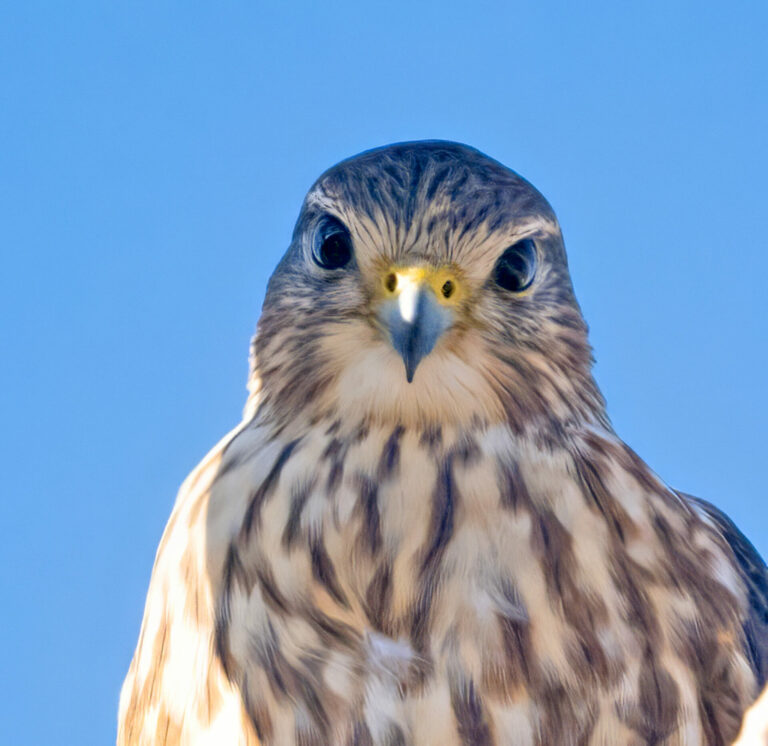
Here in Flyover Country we enjoy regular sightings of two of the North America subspecies, the Taig/Boreal Merlin (F. c. columbarius) and the Prairie/Richardson’s Merlin (F. c. richardsonii). The Taiga Merlin is the most common and widespread of the subspecies, and familiar to most North American birders, so let’s start there. Here is a classic adult female Taiga Merlin, with a streaky gray crown and a doe-eyed gaze. Click here for larger image.

Unlike many hawks, Merlins are sexually dimorphic in plumage. The males are smaller (as is the case for most hawks), but they have a more colorful plumage. This Taiga male shows those features, including a blue-gray back and a more rufous rear undercarriage. Click here for larger image.
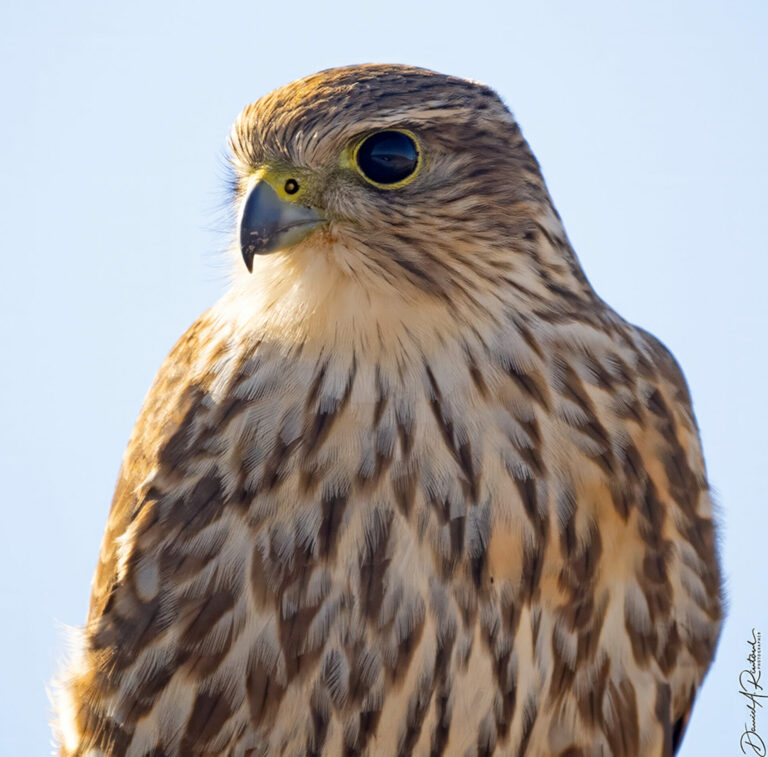
And like most other birds, Merlins have a distinctive plumage in their first year. This first-year Taiga bird has no hint of blue-gray, just streaky brown with a white throat. Males and females look similar. Click here for larger image.
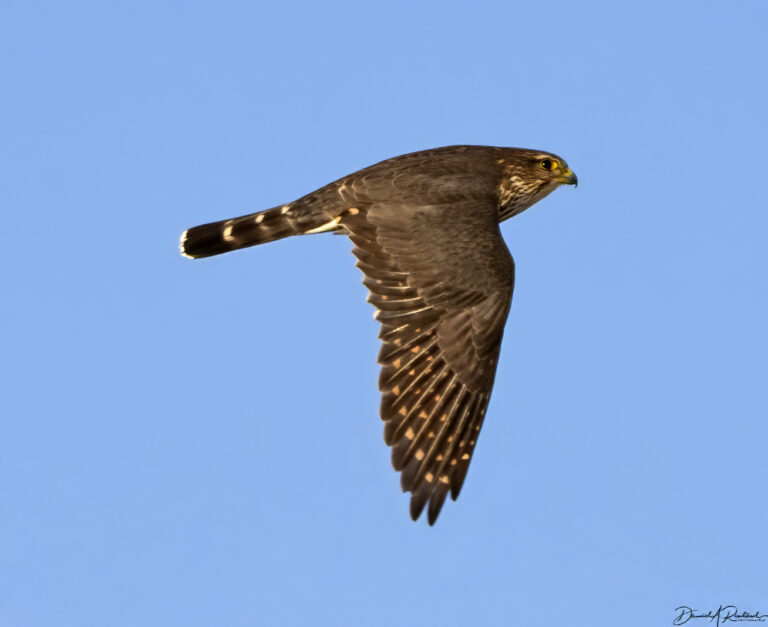
Another first-year Taiga Merlin in flight, where it displays the brown (not gray) topside and banded tail. Note also that the flight feathers are all fresh and uniformly colored. Click here for larger image.
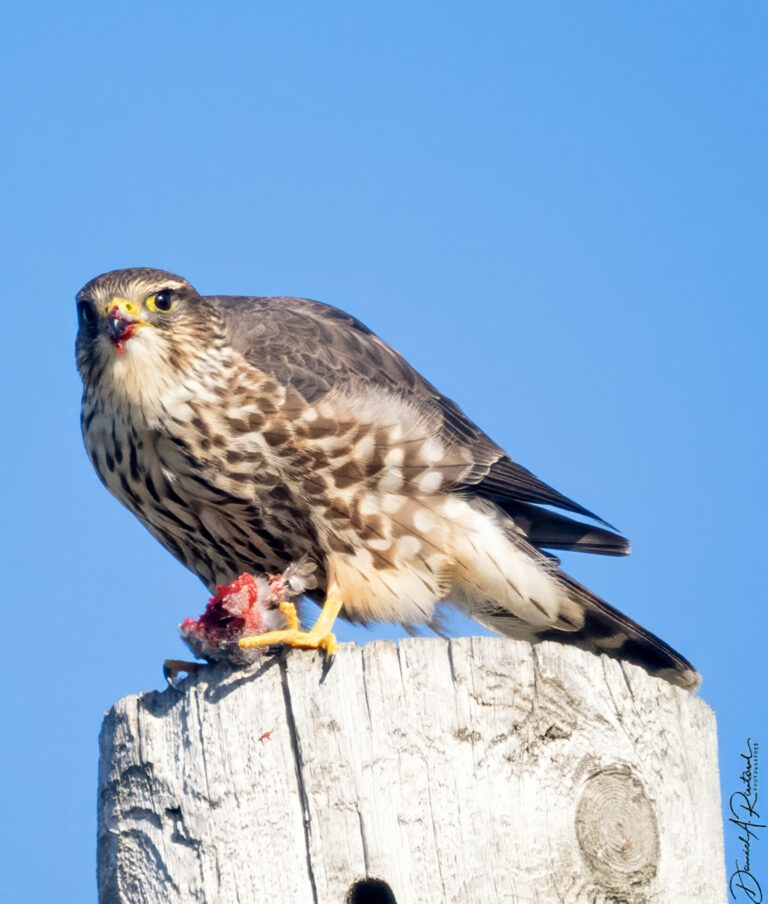
This adult female Taiga Merlin is eating a starling, but if you don’t focus on that you can see that she has a gray back, brown-streaked chest, and a white rear undercarriage. Click here for larger image.
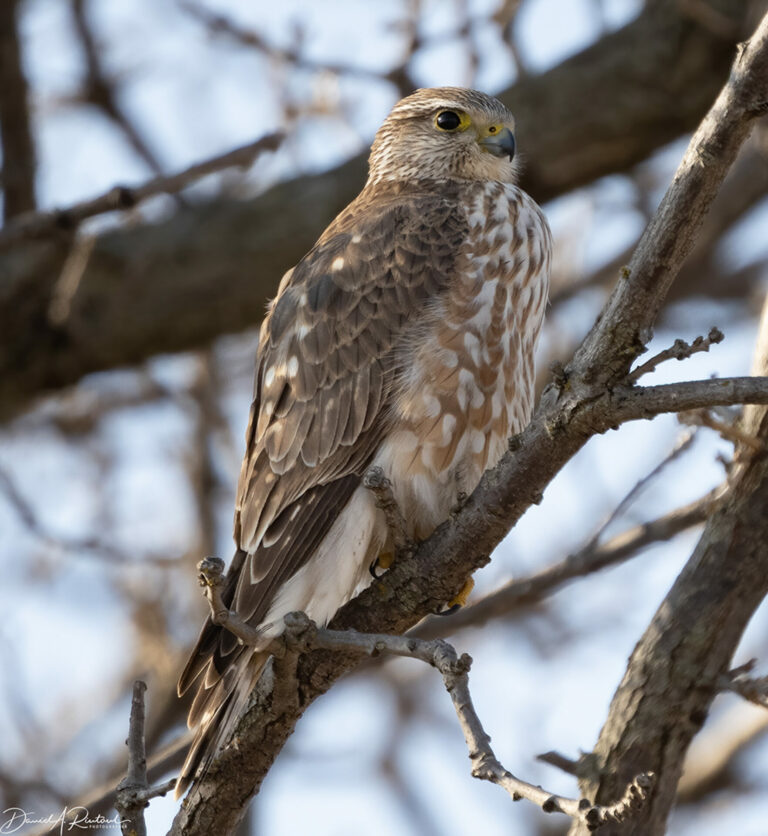
Switching gears to the Prairie subspecies, here’s an adult female, showing the overall paler coloration (especially around the face) that is a hallmark of that subspecies. This is probably a bird in her second year, since she has a mixture of newer gray feathers and older brown feathers on her back. Click here for larger image.
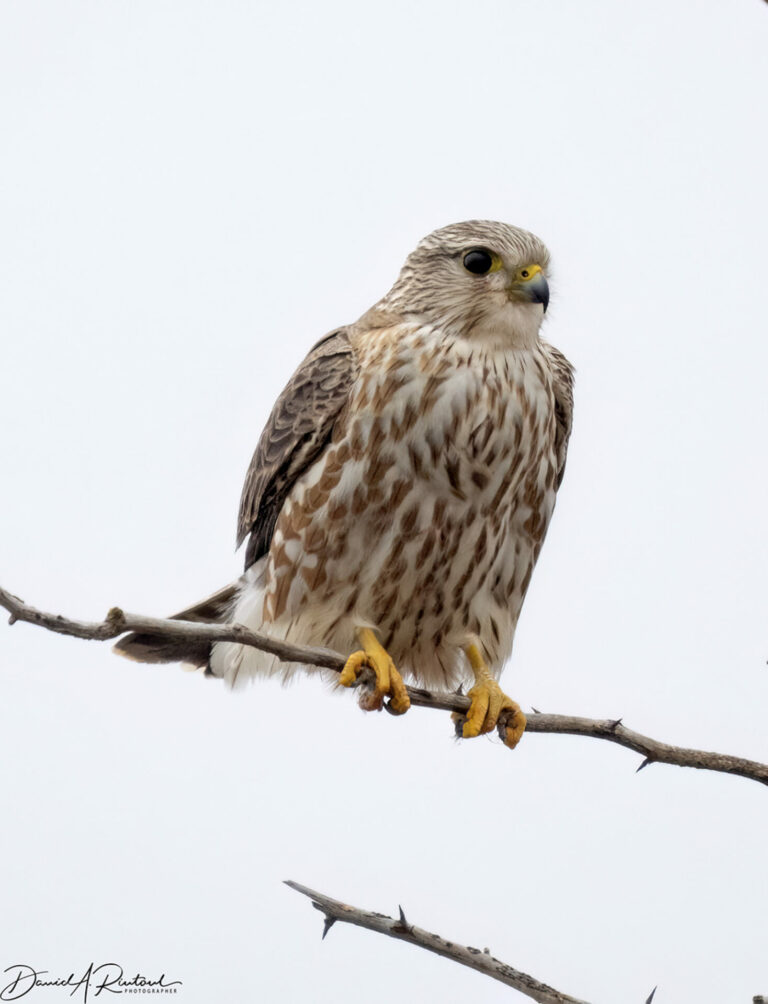
Another adult female Prairie Merlin with a very pale head. Click here for larger image.
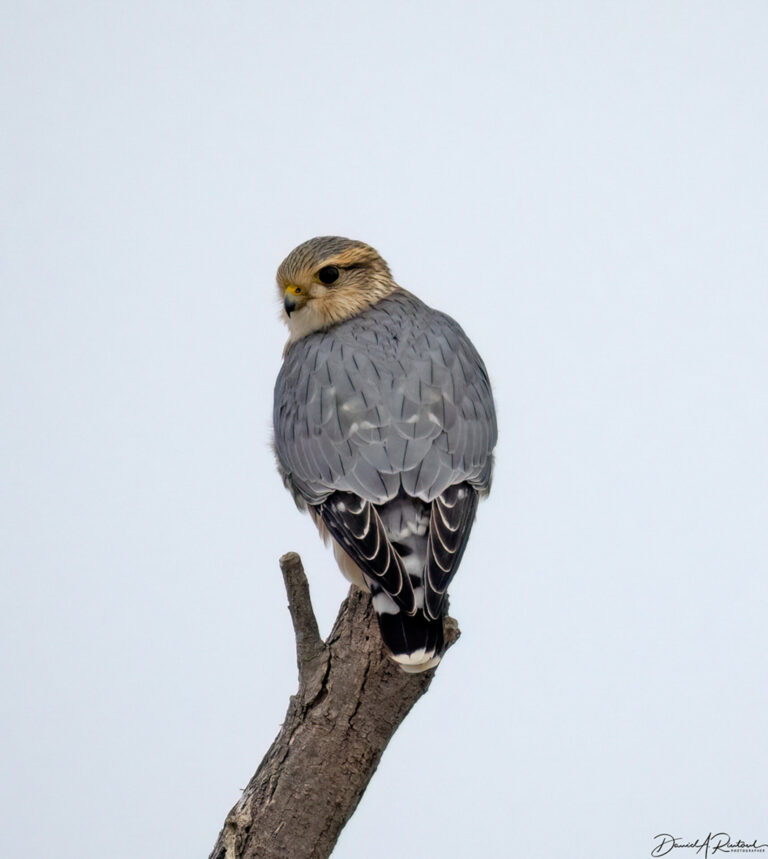
Adult Male Prairie Merlins are one of our more beautiful hawks. Pale blue-gray back, pale face, and boldly-banded tail are all good field marks for this age class and subspecies. I wish that he had turned around to show off his bright rufous thighs, but I never got a photo from that angle, alas. Click here for larger image.
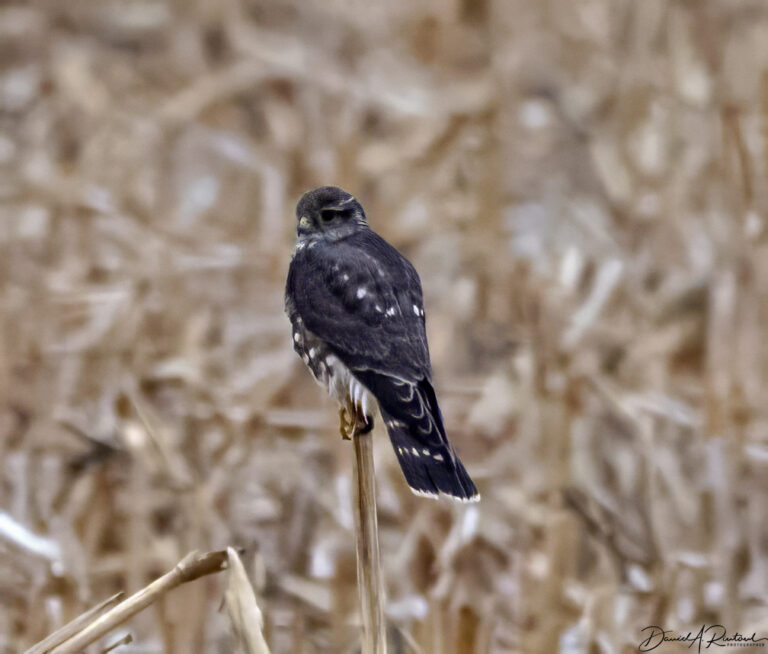
The third subspecies in North America is the Black Merlin (F. c. suckleyi), which breeds in the Pacific Northwest. There are scattered records east of there, but the conventional wisdom is that they are not found east of the Rockies, However, there are eBird records for the east side of the Front Range in Colorado, one in far western KS, and a couple in Texas. This very dark bird is probably not a Black Merlin; I am told it is just a verrrrry dark Taiga Merlin. So I remain in search of this mythical beast here! Click here for larger image.

As mentioned above, Merlins have an attitude. So do their smaller cousins, the American Kestrel (Falco sparverius). This young (probably male, judging from the size) Taiga Merlin was bullied off its branch by a feisty resident male American Kestrel. Click here for larger image.

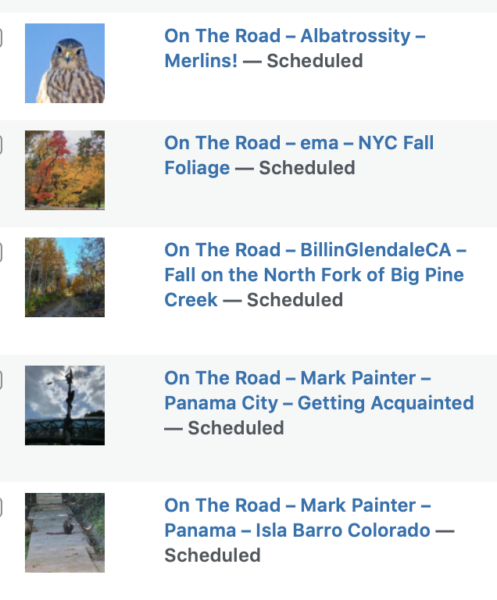
Barney
On falconing:
(A musket is a male sparrowhawk, so presumably the priest’s was female)
Beautiful pictures.
Scuffletuffle
Love your photos, such beaitiful birds!
SteveinPHX
Thank you. And I would agree, that’s kind of a pugnacious look about them.
oldster
So beautiful! Like cats: cold-blooded killers that you somehow want to cuddle. Thanks for all the great photos.
OzarkHillbilly
I rather doubt I could ever tell the difference between a Taiga Merlin and a Prairie Merlin in the field. Oh well, at least my week has begun on the right Albatrossity foot. Thanx much.
eclare
That first photo is awesome! What an attitude.
Wag
I would propose a Spell of Merlins as an appropriate name for a flock of these magnificent creatures.
Torrey
Amazing pictures, and thank you for the descriptions and explanations. Also, I love the sight of dinosaurs in the morning!
Albatrossity
@Wag: That is an excellent name!
Glidwrith
@Wag: I favor a Merlot of Merlins. High quality birds!
Yutsano
Yay! More raptors!
stinger
How appropriate that the top image is of a lady hawk! And what a gorgeous photo it is!
@Wag: I was going to propose “a Wrist of Merlins”, but Spell is better!
J.
Love these! And in addition to a Spell of Merlins, I would like to suggest a Wand of Merlins.
StringOnAStick
That last photo is bursting with energy!
I like the idea of single species posts. I’m getting more and more “birdy” by the day and I find myself thinking of things like how to build shelter for the CA quail to escape the neighbourhood cats. One of the reasons our cats were raised as indoor only is the bird predation issue, but our yard has become contested territory for at least 3 different cats now and I want to protect the quail, especially in baby quail season next spring.
S Cerevisiae
Merlins are fascinating to watch. I worked at a state park in Minnesota and a pair nested in a spruce tree just across the yard from the park office, we watched them raise 4 chicks. We always knew when it was feeding time because they made a lot of noise. Merlins are afraid of nothing, I saw them chase off ravens, eagles, and even a blue heron. When I hear them call then I know it’s spring again.
way2blue
Doe eyed? Falcon? Hmm.
EighthCousin
Late…because “left coast”, but many thanks for the photos and details that are not always in the guides. Merlins are not often seen here (Santa Cruz and adjacent counties in CA) and also seasonal, but I have seen a few.
BigJimSlade
@Albatrossity: I was going to say a coven, but a spell is much better. Going by their looks, maybe leave wizardry behind and call them a squadron.
Betsy
Fun fact: Falco columbarius means “pigeon hawk.”
The kestrel is Falco sparverius, “sparrow hawk.”
Named for their prey types, in a very general sense. I think kestrels eat about as many grasshoppers as sparrows.
mvr
Merlins are cool. I appreciate the one-species post and will come back to it.
Thanks!